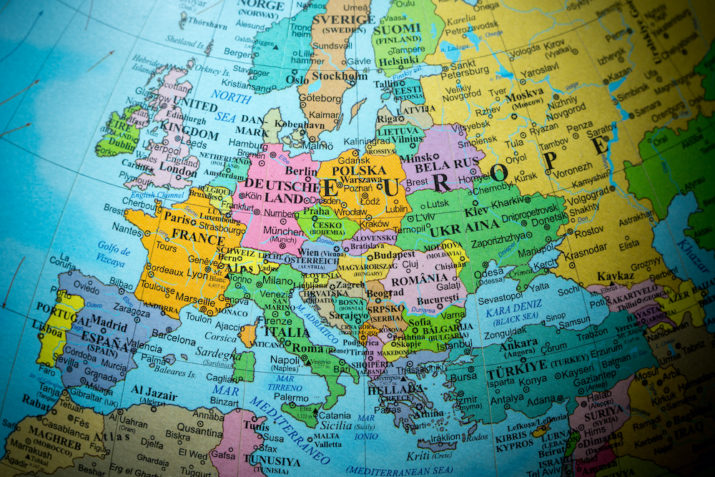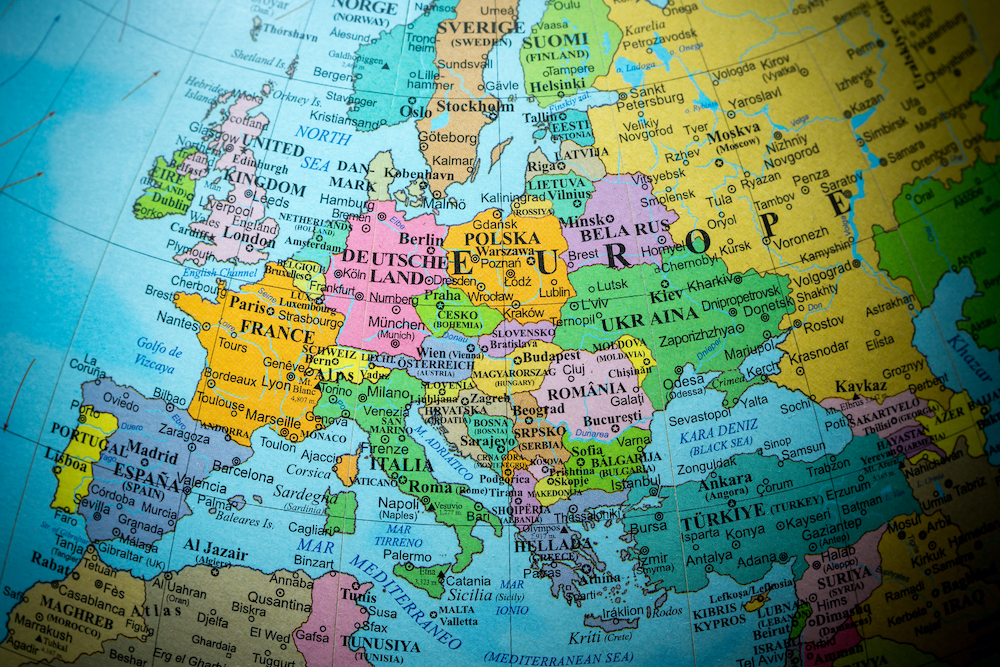

This is part of our special feature, Imagining, Thinking, and Teaching Europe.
Geopolitics of Europe
With its fifty sovereign states, Europe’s continental mass spreads all the way to Asia, from which it is separated by the Ural Mountains, Ural River, Caspian Sea, Caucasus Mountains, Black Sea, and Turkish Straits. Europe is the fourth continent in the world in terms of population and the fifth in terms of surface. Its economic, political, military, and cultural power makes it significant on the world stage. Historically, European countries have colonized much of the world, except powerful Empires they could not conquer or far and mountainous places in Asia it could not access. Four European languages (Spanish, English, Portuguese, and Russian) are among the top seven by number of native speakers, with three of them among the top five (English, Spanish and French). Three European countries are permanent members of the United Nations Security Council and twenty-eight out of thirty NATO members are Europeans. And, as of May 2020, apart from the United States, European countries have been the most impacted by COVID-19 in terms of absolute number of cases and deaths.
Europe, thus, has played an important geopolitical role, in particular through the European Union from the twentieth century on, even though the latter faces two major challenges to become a one and only voice in the world: a lack of political cohesion among its member states and limited European citizenship.
The President of the European Council declared that the EU needs to be a confident global leader as the “world is changing at lightning speed… and how we respond to these changes will define influence Europe’s future”. The Council of Europe, made of forty-seven states and the EU brings together twenty-seven members. According to the International Monetary Fund, in 2019, the EU was the second territory in the world by nominal Gross Domestic Product, after the United States, and the third by Gross Domestic Product based on purchasing power parity (GDP PPP), after only China and the United States. Four European countries are in the top eight world economies: Germany, the United Kingdom, France, and Italy. Fortune Global 500 ranks three European companies in the top ten global corporations worldwide, while 132 in the top 500 belong to those four countries plus Russia, Spain, Switzerland, the Netherlands, and others. The top six airlines in the world (by annual passenger numbers) are registered in three European countries. But what is the role that Europe will play in the upcoming decades of the twenty-first century? Geography and geopolitics helps to understand Europe in the global context.
Geography for the European project
Geography is an academic subject and scientific field that studies the Earth’s surface, the spaces and places where relationships between people and environment emerge. It explores the interactions between the physical environment and human societies producing landscapes, distributions, impacts, and spatial patterns at different scales, from the local and regional to the national and global. Indeed, geography is the science of “where,” which guides the inquiry process to acquire knowledge about how and why place, space, and environment matter. As it contributes to raise awareness about the human and cultural diversity on the Earth, geography studies locations, but also how these variations occur over time. It is a scientific discipline that deals with the teaching and learning of the processes of spatial organization of human societies, and as such, it is able to face the complexity and diversity of processes, systems, and interconnections between human and natural environments by developing analytical thinking (data, visualization), critical thinking (judgment, assessment) and lateral thinking (creative, problem-solving).
As a scientific discipline, geography emerged in Europe during the nineteenth century, with the founding of Geographical Societies in Paris, London, Berlin, Vienna, Saint Petersburg, and Madrid, as well as with the creation of Chairs of Geography in Universities, and the development of geography as a school subject, in particular in Germany and France after 1870. Today, European geographers are productive in terms of the number of higher education teachers and students, publications, presentations at international conferences, and on-going research projects. National geography organizations are particularly dynamic (Vandermotten 2004) in the United Kingdom, Germany, France, Spain, Italy, the Netherlands, and the Scandinavian countries.
The age of neo-geography and the virtual space
Ever since they sketched three-dimensional paintings in caves or on primitive maps during the Upper Paleolithic, to the time of Ancient Empires (Babylonia, Greece and Rome) to America’s discovery, and the exploration of modern Empires, (Spanish, British, French, etc.), humans have needed to make spatial representations of where they lived and where they roamed. Geography, mapping, and spatial knowledge became essential for the development of civilizations through trade, territorial conquest, and regional administration, but also for displaying the self-image and self-consciousness of political power. Geography as a science was shaped during the nineteenth century, but its dissemination in universities worldwide only became possible after 1949 as a result of the efforts and support of UNESCO to geographical education in developing countries. UNESCO believed that geography was a key school subject for international understanding (De Miguel et al. 2018).
In the decades following World War II, geography consolidated in higher education. Most universities in developed countries had a Department of Geography, undergraduate and graduate programs, research outcomes, and more. However, the discipline came to be dominated by Anglo-American scholarship. Johnston and Sidaway (2016) show that about 80 percent of all papers published in top geography journals are written by English-native speakers, whether in quantitative geography (Geographical Information Systems or GIS), humanistic geography, behavioral geography, postmodern geography, cultural geography or critical geography.
Today, with the spread of new geospatial technologies allowing easy access to geographic information and geographic media resources, geography is accessible to all more than ever. Technological applications and user tools have become readily available through computers, tablets, and mobile phones. Offering broad access to geo-information sources, these new tools have revolutionized the way in which people interact with place, space and environment, and go about their daily activities or movements, from local to global scales.
The world of GIS (desktop or web-GIS like ArcGIS Online), virtual globes (Google Earth), digital map and GIS viewers (Google Maps, Open Street Map), and geo-information based smart phone apps (including social media) has dramatically changed the way in which people interact with produce, consume, and exchange geographical information. The neologism “neogeography” describes the use of geographical information and geo-tools for personal or social activities by non-experts. Neogeography and Volunteered Geographic Information (VGI) in the virtual space is enabled since the acquisition and compilation of geographic data have become much easier as technology has advanced, thus blurring the distinction between the non-expert amateur and the expert professional geographer (Goodchild 2009). In other words, the geo-information that is essential for our contemporary personal, social, or professional life has become accessible to many more people than it was in the past.
The contribution of geography to the understanding of Europe in the world: EUROGEO
Harold Mooney—a highly cited ecologist—suggested that we are now living in the era of the geographer. A 2010 report by the Committee on Strategic Directions for the Geographical Sciences in the Next Decade (National Research Council, 2010) that asked about the most important geographical questions deserving of scientific, social, and political attention to understand and respond to a changing planet, highlighted four strategic directions where geography could provide solutions to avoid impacts and a better understanding of global challenges such as: environmental changes, sustainability, spatial reorganization of economy and society, and technological change. These four strategic directions came out of eleven questions aiming at identifying the contribution geography can make to tackle global challenges:
- How are we changing the physical environment of Earth’s surface?
- How can we best preserve biological diversity and protect endangered ecosystems?
- How are climate and other environmental changes affecting the vulnerabilities of coupled human–environment systems?
- How and where will ten billion people live on Earth?
- How will we sustainably feed everyone in the coming decade and beyond?
- How does where people live affect their health?
- How is the movement of people, goods, and ideas transforming the world?
- How is economic globalization affecting inequality?
- How are geopolitical shifts influencing peace and stability?
- How might we better observe, analyze, and visualize a changing world?
- What are the societal implications of citizen mapping and mapping citizens?
Although this questionnaire applies to the whole world, these are all geographic questions that are essential to the European project and the crises it has been facing. From a European perspective, the Geocube project led by the European Association of Geographers (EUROGEO) defined six main issues to underline the importance of geography in addressing contemporary challenges in Europe and concerns over our ways of life and relations with the world around us (Donert, 2009):
- Living together
- Earth from all angles
- Shrinking planet
- Fascinating Earth
- Exploring our world
- Useful geographies.
Each aspect comprises six geographical sub-topics, resulting in a total of fifty-four paths of inquiry. Out of those, EUROGEO has further selected a few issues as particularly relevant to the promotion of innovative teaching and learning of geography in Europe and to a better understanding of twenty-first century challenges (De Miguel and Donert 2014): climate change, global warming, sustainable development, conservation of resources, landscape, natural hazards and disasters, renewable sources of energy, national and international migration, slums, urbanization, smart cities, human development, food and water supply, transportation, population pressure, civil rights, etc. All of these topics should be familiar, as every human being is rooted in a place and any impact on place has direct consequences on daily life and subsistence. The United Nations has understood the role geography has to play. Its 2030 Agenda’s seventeen Sustainable Goals are indeed mostly spatial challenges that will require the involvement of governments, the private sector and private stakeholders worldwide, and geographic thinking
Geography can play an increasingly important role in enabling spatial analysis and spatial citizenship, empowering governments, companies, individuals, and stakeholders in participating in decision-making about European challenges from the local to the global. Well-trained geographers offer geospatial skills in diverse areas such as hazard management, environment and sustainability, local and regional development, land use planning, cultural heritage, retailing, tourism, security, and utilities. As a result, geographers have been much sought after in the European workplace since their research contributes to the six priorities of the European Agenda that are based on EUROGEO approach:
- The European Green Deal: climate change and circular economy research education and policy recommendations. Geographical outcomes address these issues and specific initiatives have engaged and advised stakeholders on, for example, the importance of understanding the ocean and in developing modern sustainable digital agriculture.
- An economy that works for people, relating especially to developing and sharing innovative practices to encourage lifelong education and employment of those most at risk. Geographers are also specialists in local and regional development, and in regional imbalances reduction policies.
- A Europe that is fit for the digital age. European geographers have led the promotion and implementation of digital Earth technologies and open data, training different target groups, implementing cutting-edge technologies, and developing involvement in the digital skills and job initiatives.
- The protecting of a European way of life, by promoting European citizenship and sustaining European values and cultural heritage.
- A stronger Europe in the world: EUROGEO hold a consultative role at the United Nations and has usually been the only geographical voice ―from Europe but representing geographers from all over the world―in some bodies like UNEP or UN-Habitat. EUROGEO also has participatory status at the Council of Europe
- A new push for European democracy: geographers have led the way in promoting innovative ways to engage and empower young people in democratic processes through geospatial technologies and open data.
European geographers’ contribution to sustainable development policy
European geographers have made essential contributions towards the achievement of the United Nations Agenda 2030 and Sustainable Development Goals—or SDG (Liverman 2018). Despite their transversal approach, the SDGs extend a spatial concern about the main challenges facing the world today: ecological, economic, social and political. All aspects of geography education are key. Physical geography has traditionally been devoted to research into the biosphere and hydrosphere, while human geography has studied peoples and places and how different societies settle over the geographical space, organize politically, and develop productive activities, as well as their impact on the environment. A reflection on the Sustainable Development Goal is intellectually indebted to the different fields of study of geography that have been scientifically consolidated over decades.
During the 2019 United Nations High-Level Political Forum for Sustainable Development, the EU asserted that “the European Union and its Member States are at the forefront of adopting the 2030 Agenda.” The EU has pursued the SDGs as one of its flagship initiatives through a reflection paper on a “More sustainable Europe by 2030,” which highlights the European Commission policy related to SDG. The paper further reveals the geographical issues that are at the core of the EU’s agenda for 2030: the European Pillar of Social Rights (social geography), EU Youth Strategy (social geography), Investment plan for Europe (economic geography), Horizon 2020 research and innovation program (geographical and interdisciplinary research), Clean planet long-term vision (environment), EU action plan for nature (environment), Urban agenda for the EU (urban geography and urban planning), and EU cohesion policy (regional geography and regional planning), among others.
To monitor, analyze, and visualize sustainable development and the spatial effects of EU’s policies on its member states, regions, and municipalities, the European Commission has deployed several initiatives and tools, such as Eurostat, GISCO, ESPON, the European Forum for Geography and Statistics, Copernicus, and the INSPIRE Directive. Geographers have contributed decisively to these programs’ success.
In comparing Europe with the United States, we see that in the US, geographer practitioners (outside the education sector) are often qualified either as urban planning professionals (AICP) or GIS professionals (GISP). For non-academic positions, the American Association of Geographers (AAG) online job center shows a wide diversity of careers in business, government, and NGOs, as well as environment, landscape, community development, spatial analysis, remote sensing, weather, hazards and emergency planning, tourism, publishing, and more. In Europe, on the other hand, the professional status of geographers is differs from one country to another: In the UK, geographers are chartered through the Royal Geographical Society of Geography; in Spain, they are certified by the Colegio de Geógrafos, in Germany by the Deutscher Verband für Angewandte Geographie (professional association for applied geography). In France, there is no official certification or body for geographers-practitioners, but graduate students can become civil servants in regional planning (aménagement du territoire), local development, urban planning, GIS, and other government environmental projects.
Therefore, geographers contribute decisively to the definition, implementation, monitoring, and assessment of European policies seeking sustainable development, but also to addressing other challenges key to the future of Europe, such as European citizenship after Brexit, demographic decline, increasing regional imbalances, and European geopolitics vis-à-vis the US, China, and Russia.
Geography education gathering momentum
In recent years, there has been a growing interest in geography, inside and outside the scientific and academic community. In the US, at the high school level, Advanced Placement (AP) in human geography is one of the fastest growing AP courses with some of the highest enrollments of all AP subjects. In the UK, geography is an increasingly popular subject in schools. In France, the 2019 high school reform (Baccalauréat) has increased teaching hours for compulsory subjects, geography and history, from 150 to 180 minutes per week. In higher education everywhere, despite a decline in the number of students in geography programs, the discipline has become more diverse and even more global, with an increasing number of geographers coming from Asia and Latin America to international conferences or publishing in selected journals.
The vitality of European geographers proves that geography in Europe, and elsewhere, matters now more than ever to propose, understand, and analyze solutions to the challenges posed by globalization. Some challenges are common to all—sustainable development, climate change, demographic and urban changes, energy, water, and food supply—but others are specifically European. The European Union has been one of the most important international outcomes of the twentieth century and the post-war period. After the immense material destruction and losses in human lives caused by two world wars, the next seventy-five years have seen economic growth, increased social cohesion, territorial integration, and extension of liberal democracy based on the respect for basic freedoms: privacy, property, thought, expression, political or religious beliefs, trade, movement, and personal, economic, intellectual and cultural initiatives. Geography is a useful tool to explain the foremost right in European citizenship: freedom of movement. This is an essential contribution from Europe to the global world.
New populism, nationalism, the post Covid-19 economic crisis, and a lack of leadership have put Europe at a crossroad. Geopolitics and geo-economics may be Europe’s two main particular challenges, as it confronts other global powers. Geographers have the necessary data, skills, understanding, and thinking to give meaning to complex interconnections between politics, economy, society, culture, and the environment. In 2022, a conference in Paris will commemorate one hundred years since the establishment of the International Geographical Union. In Europe and from Europe, geographers from all around the world, will have an outstanding opportunity to explain how geography will become ever more necessary and useful in the next decades. In the twenty-first century, global trends will intensify, but places, spaces, and environments will remain still more diverse than ever.
Rafael de Miguel González earned a MA and a PhD (urban planning) from the University of Paris, France, and an EdD (geography) from the University of Valladolid, Spain. He is Professor of Geography at the University of Zaragoza, Spain, where is also Associate Dean. His recent books include research topics about urban geography and planning Urbanismo y desarrollo sostenible en Zaragoza (Prames 2010), L’aménagement métropolitain dans la planification urbaine et territoriale en Espagne (ANRT-Université de Lille 2012), Zaragoza: arquitectura, urbanismo y patrimonio cultural (Royal Academy of San Luis 2018), and about geographical education Innovative learning geography in Europe (Cambridge S. P. 2014), Geography Education for Global Understanding (Springer, 2018), Geospatial Challenges in the 21st Century(Springer, 2019), Geospatial Technology in Geography Education (Springer, 2019). He is member of the Board of Trustees at the Spanish Royal Geographical Society. He is President of EUROGEO, the European Association of Geographers, which he represents at the United Nations ECOSOC NGO Committee and UN-HABITAT. He is also member of the European Alliance for Social Sciences and Humanities.
References:
De Blij, H. 2012. Why Geography Matters, More Than Ever? New York: Oxford University Press.
De Miguel, R. and Donert, K. 2014. Innovative Learning Geography in Europe. New challenges for the 21st Century.Newcastle-upon-Tyne: Cambridge Scholars Publishing.
De Miguel, R., Bednarz, S. and Demirci, A. 2018. Why Geography Education Matters for Global Understanding? In Demirci, A., R. de Miguel and Bednarz, S. (eds.). Geography Education for Global Understanding. Dordrecht, Netherlands: Springer, 3-12.
Donert, K. 2009. Geocube: the world at your fingertips. Liverpool: Liverpool Hope University.
Dorling, D. and Lee, C. 2016. Geography. Ideas in profile. London: Profile Books.
Goodchild, M. 2009. NeoGeography and the nature of geographic expertise, Journal of Location Based Services, 3: 2, 82-96.
Hanson, S. 1997. Ten Geographic Ideas that Changed the World. New Brunswick: Rutgers University Press.
Johnston, R. and Sidaway, J. 2016. Geography and Geographers. Anglo-American human geography since 1945 (Seventh edition). London: Routledge.
Kaplan, D. 2013. The revenge of geography. New York: Random House.
Liverman, D. 2018. Geographic perspectives on development goals: Constructive engagements and critical perspectives on the MDGs and the SDGs, Dialogues in Human Geography, 8: 2, 168–185.
Marshall, T. 2015. Prisoners of Geography: Ten Maps That Explain Everything About the World. New York. London: Elliot and Thompson
Monmonier, M. 2018. How to Lie with Maps (Third edition). Chicago: University of Chicago Press.
Murphy, A. 2018. Geography. Why it matters. Cambridge: Polity Press.
National Research Council 2010. Understanding the Changing Planet: Strategic Directions for the Geographical Sciences. Washington, DC: The National Academies Press.
Vandermotten, C. 2004. Editorial. New trends and state of the geography in the European countries, Belgeo, 1.
Photo: Map view of Europe on a geographical globe | Shutterstock
Published on June 3, 2020.




